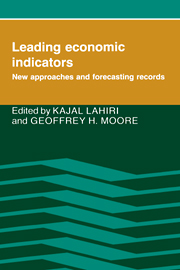Book contents
- Frontmatter
- Contents
- Preface
- List of contributors
- 1 Introduction
- PART I NEW CONCEPTS AND METHODS
- PART II FORECASTING RECORDS AND METHODS OF EVALUATION
- PART III NEW ECONOMIC INDICATORS
- 17 Commodity prices as a leading indicator of inflation
- 18 A leading indicator of inflation based on interest rates
- 19 Using composite leading indicators of consumption to forecast sales and to signal turning points in the stock market
- 20 Economic indicators for Australia's service sector
- 21 Purchasing management survey data: Their value as leading indicators
- 22 An agenda for inventories input to the leading composite index
- Index
17 - Commodity prices as a leading indicator of inflation
Published online by Cambridge University Press: 05 June 2012
- Frontmatter
- Contents
- Preface
- List of contributors
- 1 Introduction
- PART I NEW CONCEPTS AND METHODS
- PART II FORECASTING RECORDS AND METHODS OF EVALUATION
- PART III NEW ECONOMIC INDICATORS
- 17 Commodity prices as a leading indicator of inflation
- 18 A leading indicator of inflation based on interest rates
- 19 Using composite leading indicators of consumption to forecast sales and to signal turning points in the stock market
- 20 Economic indicators for Australia's service sector
- 21 Purchasing management survey data: Their value as leading indicators
- 22 An agenda for inventories input to the leading composite index
- Index
Summary
Changes in commodity prices have long played an important indicative role in analyses of global economic conditions, principally because of their importance for developing countries. More than seventy countries derive at least 50 percent of their export earnings from nonfuel primary commodities; another twenty derive the majority of their export earnings from fuels (see IMF, 1988, pp. 104–5). Changes in the terms of trade for these countries typically arise largely from changes in world commodity prices. Recently, however, attention has also been drawn to the importance of changes in commodity prices as indicators of changes in inflationary conditions affecting industrial countries. For example, the World Economic Outlook recently began to include an analysis comparing percentage changes in an index of forty primary commodity prices with the aggregate inflation rate of the seven largest industrial countries (see IMF, 1988, p. 11). The task of this chapter is to examine the usefulness of commodity prices as a leading indicator of inflation in the large industrial countries as a group.
An early exponent of focusing on commodity prices in this context was Robert Hall. In his 1982 book, Hall argued in favor of basing U.S. monetary policy on a commodity standard, with the commodities chosen on the basis of the closeness of their historical fit against the cost of living. Bosworth and Lawrence (1982) also emphasized the role of commodity prices as a contributor to the rise in inflationary pressures during the 1970s.
- Type
- Chapter
- Information
- Leading Economic IndicatorsNew Approaches and Forecasting Records, pp. 305 - 338Publisher: Cambridge University PressPrint publication year: 1991
- 12
- Cited by



